COLORED GEMSTONES HAVE long played runner-up to Americans’ love of diamonds, but change is in the air, and color is finally starting to get more attention. One-of-a-kind colored gemstones are routinely among top jewelry designers’ faves to feature in new collections, and retailers enjoy much better margins on color than its diamond counterparts. Those reasons are compelling enough to better sell color, but in true INSTORE style, we have more ideas.
In fact, we put together a comprehensive guide about colored stones to inspire sales, educate on price and availability, and familiarize you with up-and-coming gems as well as those you can find in abundance in the U.S. Also included? Treatments about which you need to know, a hot new gemstone find from Tanzania, and loads of color insights from designers and INSTORE’s Brain Squad.
Can you guess which gems reign supreme among peers? Are retailers wearing what they’re selling—are they wearing a colored stone jewel that will elicit stares and questions and make viewers realize the types of dreamy merchandise available to them? Some of our findings might surprise you.
So, take a seat, get comfy, and prepare for an epic update on all things color.
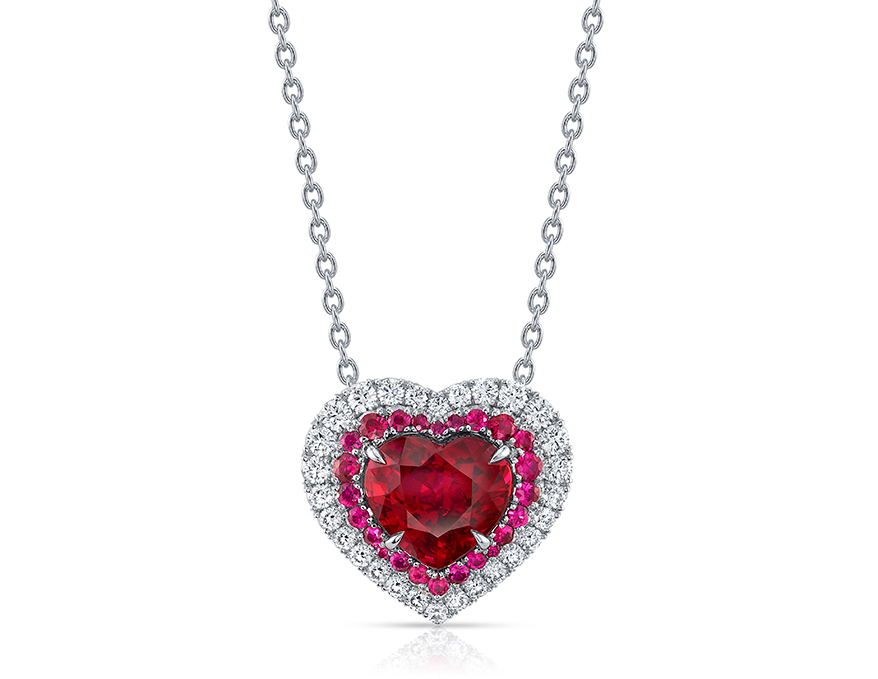
Necklace in platinum with rubies and diamonds, Omi Privé, omiprive.com
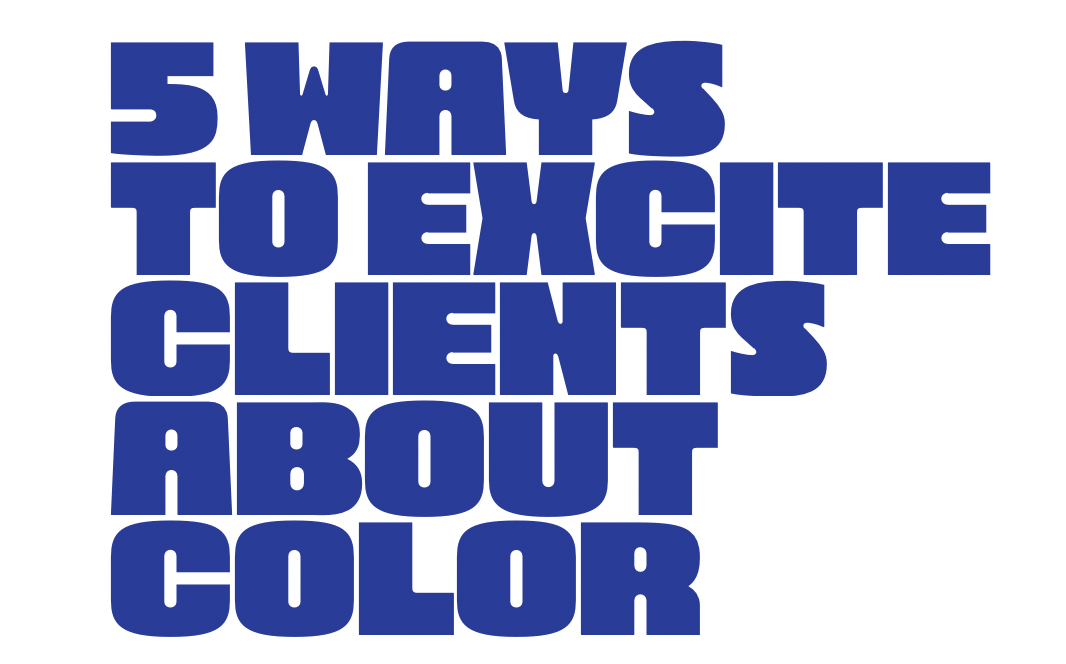
Sure, pretty gems alone are a natural temptation for collectors, but sometimes shoppers need an extra hook to take a jewel home. Here’s how the experts—gem dealers and color-loving retailers—go about thrilling clients and closing more colored stone sales.
Share the Backstory
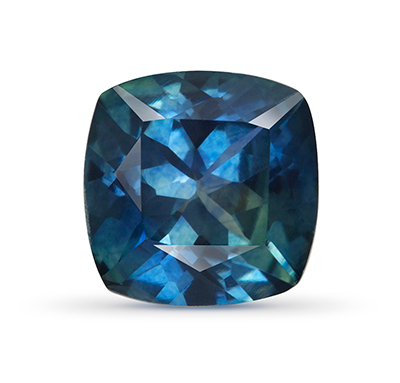
Blue sapphire from Montana, Parlé Gems, parlegems.com
1 “We use the lure of our hunt—how we go about finding stones, our trips to Sri Lanka, and our friends in the industry who mine at the source,” says Laurie Watt, Mayer & Watt. “We go to some of the sources, so we talk about that.” Ditto for Bruce Bridges of Bridges Tsavorite, who relates his family history with the green East African gem—his dad Campbell discovered the gem in 1961 and was later murdered by claim jumpers—to shoppers. “My father’s life story and legacy have become true lore,” he says.
Educate Staff
2 Sales associates must understand gem origin, rarity, treatments and color range to convey authority and interest to shoppers. Eric Braunwart of Columbia Gem House suggests merchants “know more than what their shoppers found on Pinterest.” Disconnects exist, too, among diamond-loving Americans. “Sometimes there’s no perceived value like there is for diamonds,” says David West Nytch, owner of West and Company Diamonds in Auburn, NY. “They understand the price of a $15,000 diamond ring, but don’t understand it for a $20,000 ruby ring.”

Laurie Watt of Mayer & Watt at the 2021 AGTA Denver’s Sparkle & Shine show
Use Gem Lore
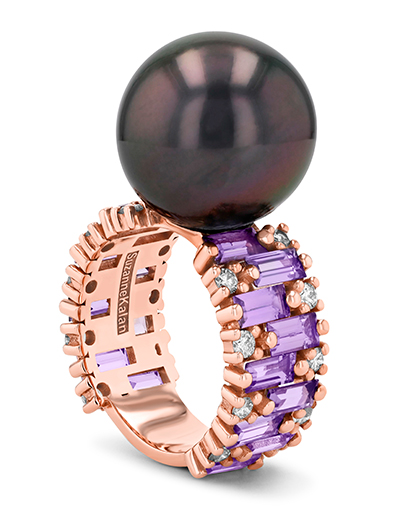
Ring in 18K rose gold with a Tahitian pearl and amethyst, Suzanne Kalan, suzannekalan. com
3 The list of obscure facts and purported qualities and meanings of gemstones is seemingly never-ending. Valerie Peirano’s fave tall tale? “Samurai soldiers used to insert rubies into their skin to make them invincible in battle,” remarks the owner and manager of Peirano Jewelers in Martinez, CA. And in the category of wacky stories is amethyst’s provocative claims of curing hangovers. “I know from personal experience it doesn’t cure drunkenness,” jokes Tracy Gibson, manager of Studio D in Woodstock, IL.
Set Up Roundtables
4 These have been an important tool for both gem dealers who sell loose and retailers with in-house bench departments. Plan seating carefully so best customers get gems first, and keep groups small—about 15 guests per gathering. Robin Johannes of Johannes Hunter in Colorado Springs has never topped her best roundtable that happened 17 years ago, though she still tries. “We did $900,000 in revenue,” says Johannes about the 2005 event.
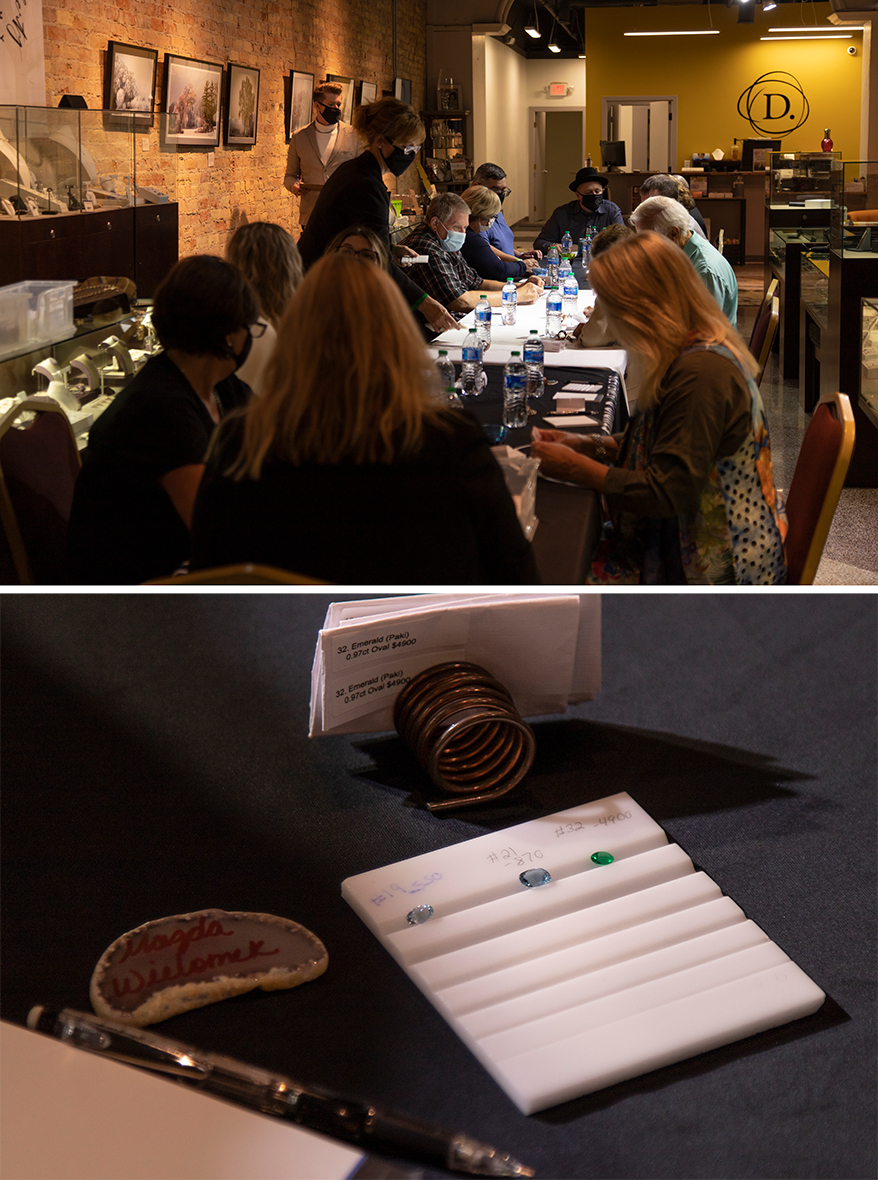
One of Studio D’s robust roundtable events held in its Woodstock, IL, store.
Get Personal
5 Share more with clients about inventory choices. “I like to present why I chose a gem for the store,” explains Becky Thatcher of Becky Thatcher Designs in Glen Arbor, Traverse City, and Leland, MI. Some stones she likes for their inclusions, while others she admires for their beautiful cuts. Don Janson of Walters & Hogsett in Boulder, CO, even tells clients about his purchase of a sapphire engagement ring for his spouse. “We don’t just believe in color, but we love it and support it,” he says.
Advertisement

Buy what you like.
1 “If you like it, somebody else will, too. It’s easier to sell something you love.” — Laurie Watt, Mayer & Watt
Have gorgeous gems.
2 “Have the best gems out there, and they will sell themselves.” — Bruce Bridges, Bridges Tsavorite
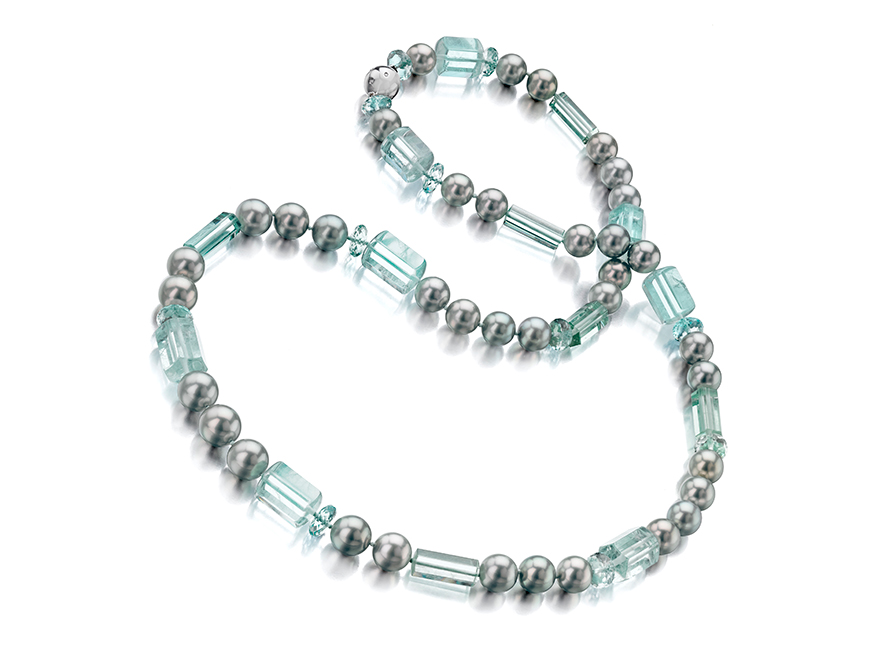
Necklace with Tahitian pearls and aquamarine, Assael, assael.com
Demonstrate savvy and passion.
3 “If you know what you are talking about—where a gem is from, how it got to the store, and its quality—and show passion, gemstones are easy to sell.” — Kimberly Collins, Kim Collins Gems and AGTA board president
Stock color.
4 “Show loose stones along with mounted colored stone jewelry.” — Ira Kramer, Diamond Exchange of North Florida, Tallahassee, FL
Put pieces on clients.
5 “Get the customer to try it on!” — Cathy Calhoun, Calhoun Jewelers, Royersford, PA
Wear pearls.
6 “This is my best tip … I wear them every day!” — Sherrie Schilling-Devaney, Sherrie’s Jewelry Box, Tigard, OR
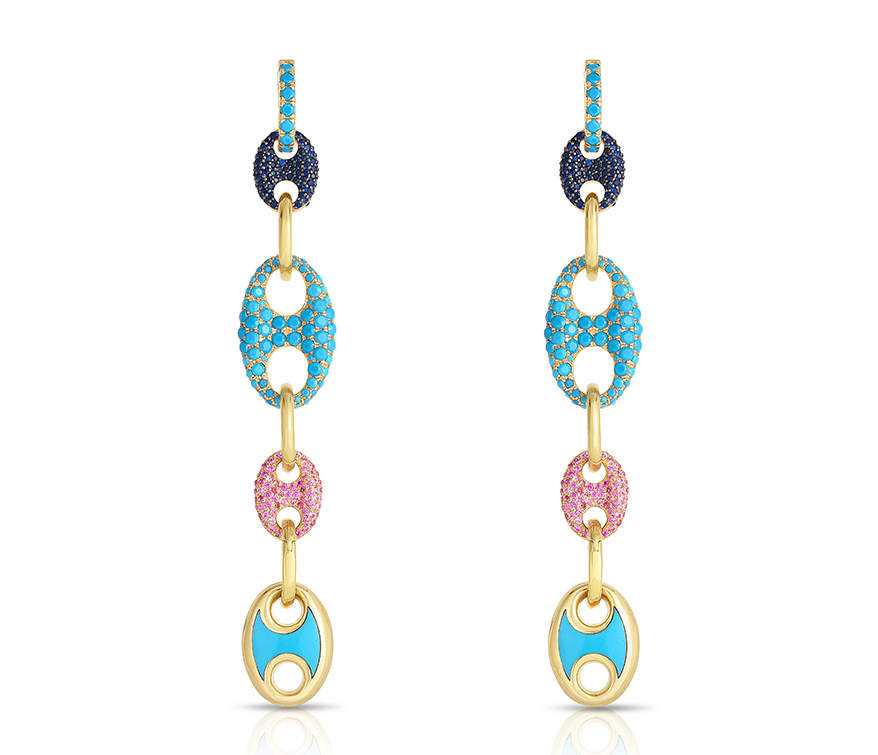
Earrings in 18K yellow gold with mixed gemstones, Fern Freeman, fernfreemanjewelry.com
Talk about the miners.
7 “Younger consumers want to know—it makes the stones more personal and exotic.” — Eric Braunwart, Columbia Gem House
Use inspiring language.
8 “Talk about the gems with such awe and enthusiasm that it is transferrable.” — Robin Johannes, Johannes Hunter, Colorado Springs, CO
Wear color.
9 “It helps clients understand inclusions and treatments, such as why a sapphire might not be heated—so its silky inclusions remain.” — Becky Thatcher, Becky Thatcher Designs, Glen Arbor, Traverse City, and Leland, MI
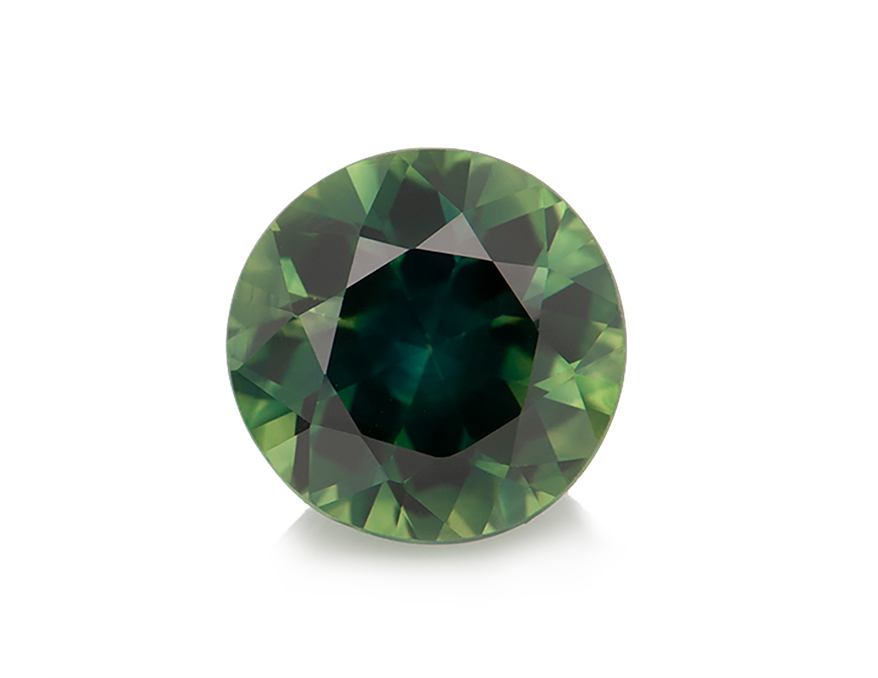
Green sapphire from Australia, Mayer & Watt, mayerandwatt. com
Own a niche.
10 “We have the fieriest opals in our area, and we sell more opals than any other gemstone because we have become known for them.” — Tim Wright, Simply Unique Jewelry Designs, Yorktown, VA
Talk about healing properties.
11 “Our customers also collect crystals, so they are interested in knowing the benefits of wearing labradorite or why giving a gift of tourmaline is a nice idea.” — Laura Kitsos, Gem Jewelry Boutique, Oak Park, IL
Sell by month.
12 “Know your birthstones. Uniqueness is a selling point.” — Autumn Knight, Arizona Watch & Jewelry Service, Tucson, AZ
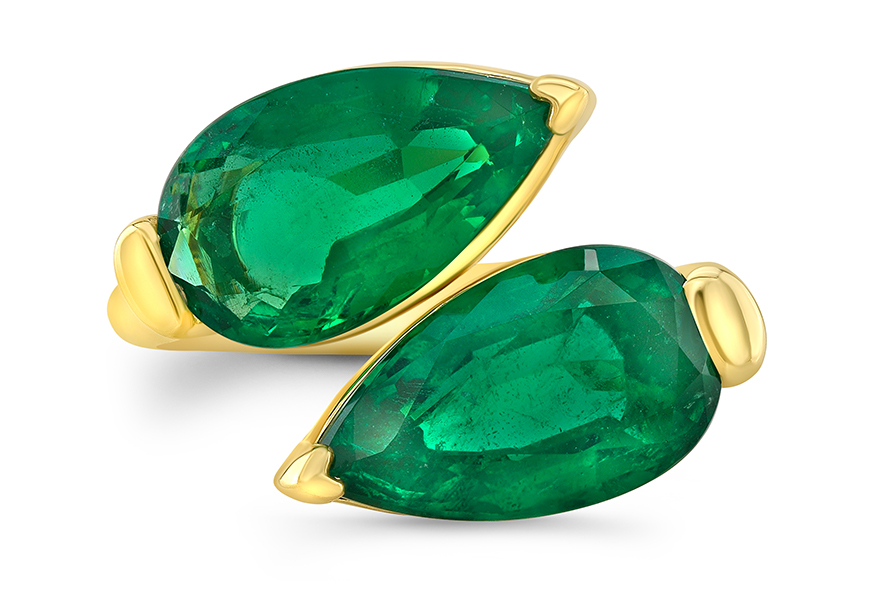
Bypass ring in 18K yellow gold with emeralds, Rahaminov, rahaminov.com
Get smart.
13 “Become a gemologist first.” — Barry Fixler, Barry’s Estate Jewelry, Bardonia, NY
Have variety.
14 “Get a few options from different suppliers. Use the stones that are more expensive or not as nice to help sell the nicest one.” — Jeremy Auslander, Roxbury Jewelry, Los Angeles, CA
Use the rainbow.
15 “Group color schemes together.” — Krystal Shiklanian, Radiant Fine Jewelry, Plymouth, MI
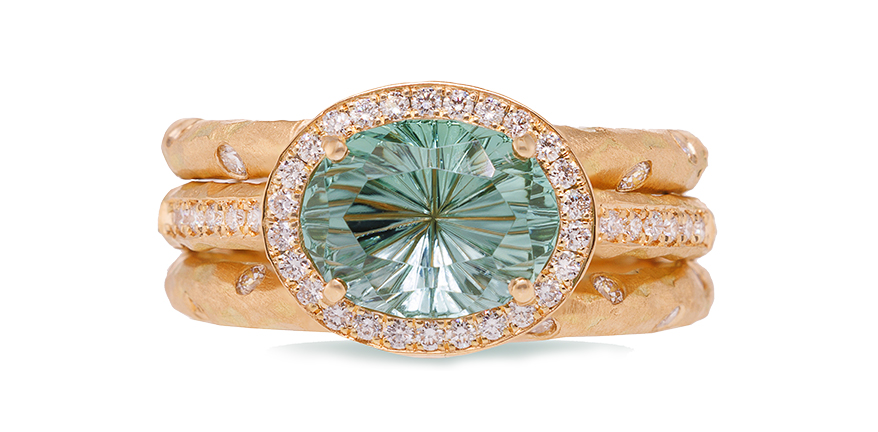
“Tourmalines are delicious because they come in such a wide array of colors: pink, watermelon, green, and bicolor.” — Pamela Froman, Pamela Froman Fine Jewelry
Advertisement

When mining circumstances or market prices change, opportunity arises for gems that, for whatever reasons, may have been previously overlooked. Maybe its name is a turnoff (hello, zircon!) or the price of a “Big Three” stone like ruby has gotten cost-prohibitive, thereby opening the door for a lesser-known variety to shine, but these are the gems that dealers say are worth considering now.
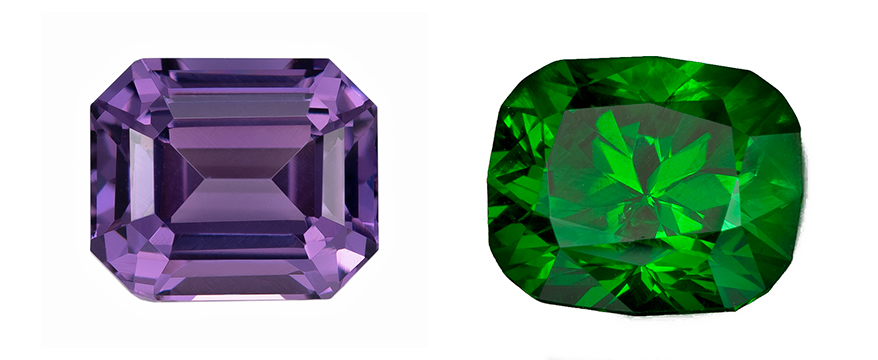
Purple spinel, Gem 2000, gem2000.com Demantoid garnets, Evan Caplan, evancaplan.com
Tanzanite
The popularity of the beautiful bluish-purple gem found in northern Tanzania in the late 1960s ebbs and flows. According to Stuart Robertson, research director at The GemGuide, now is a good time to reacquaint yourself with it. “Tanzanite is available and affordable now compared to its peak years in the 1990s,” he says.
“Everyone has heard of it but maybe not thought of it in a while.” Tanzanite is routinely heated to summon its striking hues and is on the soft side of the Mohs scale at 6–7.
Spinel
This gem has been riding a wave of popularity for upwards of 10 years with no end in sight. The industry loves spinel for its prized range of colors (red, purple, hot pink, blue, and more) and its high refractive (passage of light) and relatively high dispersion (fire) indexes. Zircon is also durable (an 8 on Mohs), widely found in many countries, and the prices of reds are affordable compared to rubies. Plus, historical uses of the gem, which was mistakenly called ruby in pieces like England’s Black Prince’s Ruby, speak to just how regal an option it is. Spinel is rarely treated, but fracture filling of it is an on-the-horizon issue in the gem community.
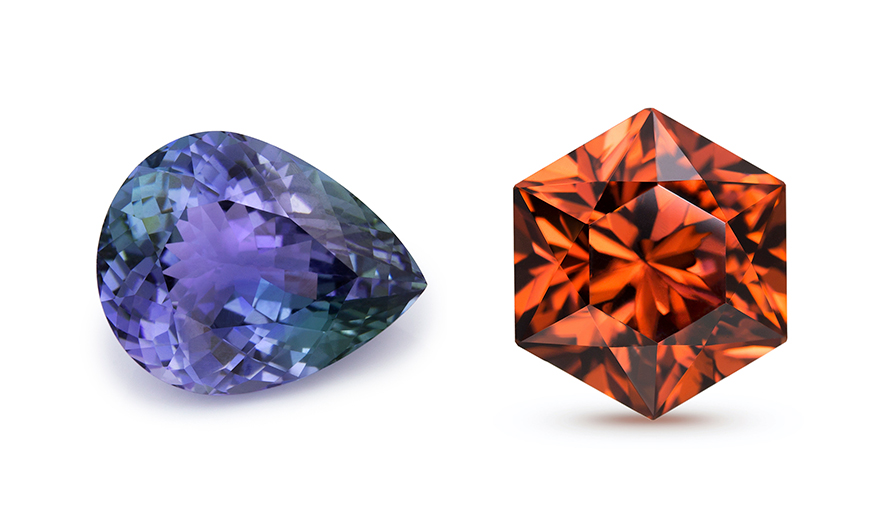
Bi-color tanzanite, Parlé Gems, parlegems.com. Orange zircon, ANZA Gems, anzagems.com
Zircon
This fiery gem with an unfortunate name—many confuse it with cubic zirconia—has a high refractive index and dispersion rates and is found in a wide range of colors. While the earthy cognac hues are natural, blues are routinely heat-treated but stable, so the color won’t fade. “I still think blue zircon is underpriced,” says Ann Barker of Barker & Co. “You can still get a nice stone for a decent price.” The gem is on the soft side of the Mohs scale, ranging from 6–7.5, and is found in many international locations.
Garnets
All share the same crystal structure, though different chemistries account for their wide range of colors: red, orange, purple, purplish-pink, green and yellow. Garnets are found worldwide, have a high refractive and relatively high dispersion index, and are super affordable compared to other gems. Experts say they are hugely undervalued and rarely treated. “Garnets don’t get as much attention as they should,” remarks Shane McClure, director, West Coast identification services, GIA. One caveat: The tsavorite and demantoid species are commonly found in small sizes.
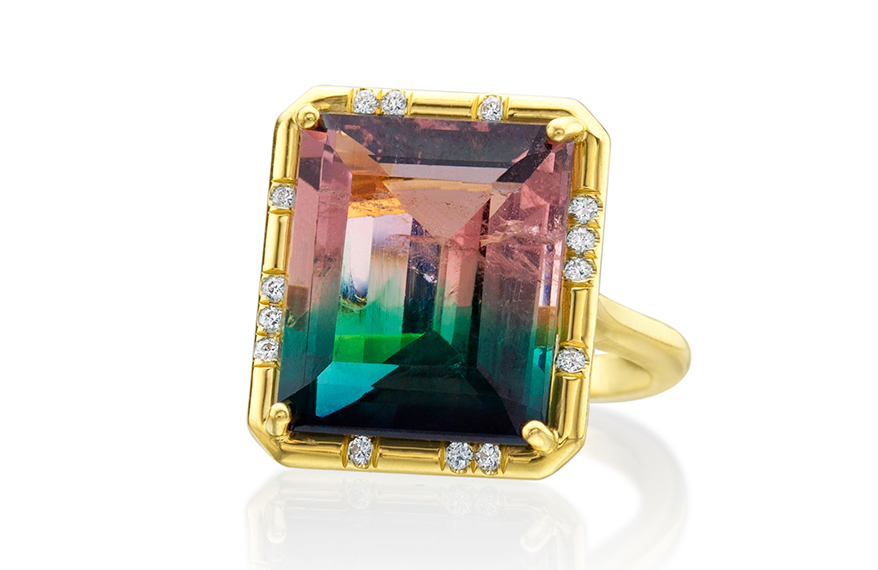
“We love to work with tourmalines and find them in a kaleidoscope of colors and a variety of shapes and sizes. The design possibilities are endless. Since they are relatively strong stones, they are perfect for everyday wear.” — Lauren Kessler, Lauren K Fine Jewelry NY

Prices for most gems are up across the board, a scenario rooted in the height of the pandemic. When Covid-19 struck, mines closed, dealers weren’t traveling overseas to buy, and many miners were forced to find employment elsewhere. Some haven’t returned, even as mining operations slowly open. This is causing a shortage of top-quality goods in the market, and what’s available costs a lot more.
Political and economic turmoil are also wreaking havoc in select gem-producing countries. Sri Lanka is a major producer of sapphires, and the island nation recently went bankrupt and saw a storming of the prime minister’s property by residents outraged at high inflation. Widespread power outages and a diesel fuel shortage hinder cutting and heating efforts.

A miner on site at Prosperity Earth’s demantoid mine site in Madagascar
Madagascar is another major sapphire source, but it has stopped the export of rough and doesn’t maintain a sizable cutting center like Sri Lanka. The result is halted exports of the top-grade gems that American dealers covet.
Meanwhile, Myanmar’s (formerly known as Burma) rocky political history means U.S. dealers still largely aren’t importing rubies, jade, or pearls from the Asian nation.
Overall, expect to pay more for gems. Specifically, dealers say prices of gray spinel are up a minimum of 10 percent, sapphires and tourmaline are both up at least 20 percent, and zircon is up as much as 40 percent. “At JCK Las Vegas, we bought a fair amount but couldn’t find everything I wanted at a price I could pay and still make a little money,” reveals Ann Barker of Barker & Co.
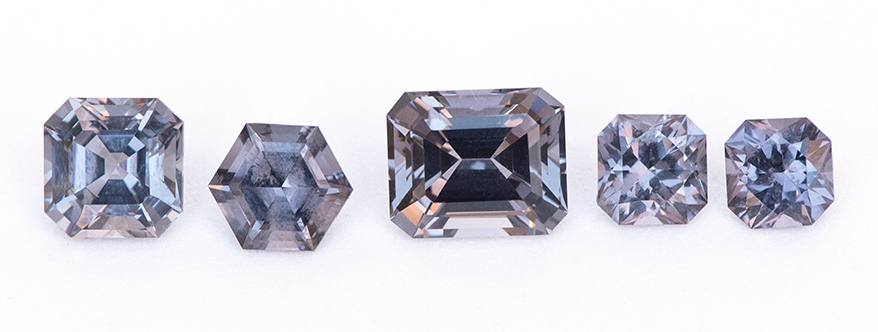
Gray spinel from Kim Collins Gems, kimberlycollinsgems.com

The most-talked about gem of 2022 is a new find of cobalt blue spinel, found near Mahenge, Tanzania—the source of some highly prized hot pink spinel.
Mahenge Gems is credited for bringing the cobalt blue spinel to JCK Las Vegas this year. Established in 2020 in Singapore, Mahenge Gems, helmed by Wez Barber and Rimsan Nifal, specializes in gems from the general region of East Africa, which include spinel, garnet, and no-heat tanzanite and sapphire, as well as the new blue spinel.
That material debuted to the international market in fall 2021. Fortuitously, Mahenge’s Tanzanian office is right near the mines, a scenario from which it benefitted in terms of purchasing rough, though it declines to say how much. Barber says supply is already dwindling.
“Today there’s only a fraction coming into our office compared to January 2022,” he says.
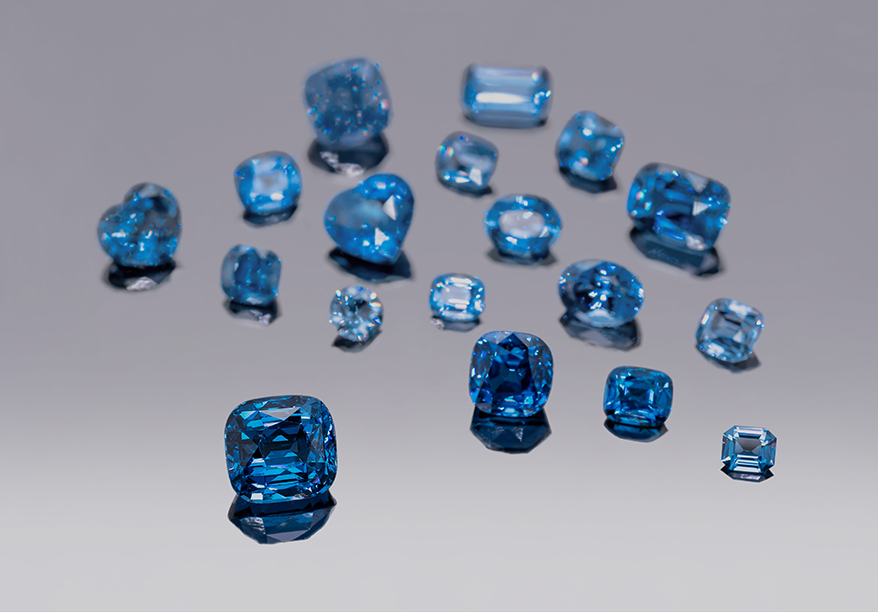
Tanzanian cobalt blue spinel cut by Mahenge Gems, mahenge.com
To date, GRS GemResearch Swisslab, the ICA GemLab, and SSEF have all tested the gems and confirmed samples were cobalt blue spinel and that they weren’t treated.
The majority of Mahenge Gem’s blue spinel is available in 1-carat sizes, though stones as large as 10 carats have been found. Prices start at $5,000 per carat for 1–1.5 ct. stones up to $20,000 per carat for the top hues. Larger stones can go up to $40,000 to $50,000 a carat.
Not surprisingly, those who saw the gems at the show compared them to blue spinel from the Lục Yên district in Vietnam, an important producer. “People were excited by the possibility of large sizes, how clean the material is compared to Lục Yên, and the electric color,” adds Barber.
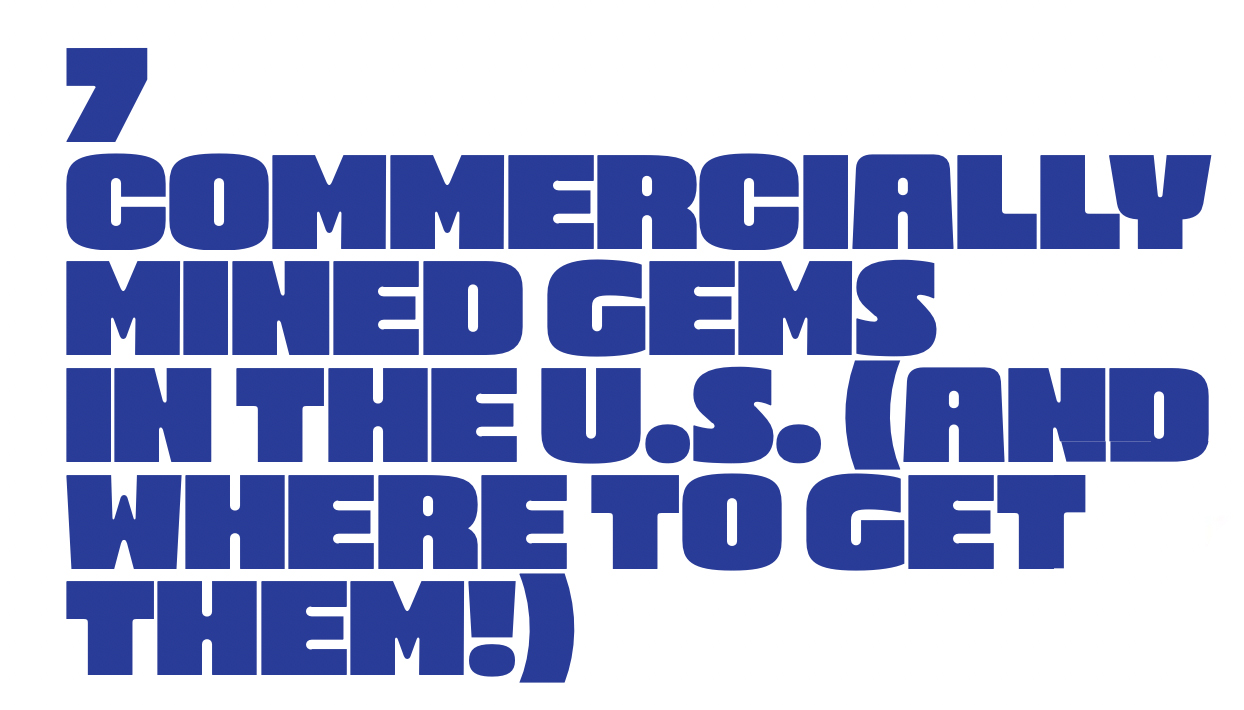
U .S. gem lovers don’t need to leave the States to find pretty stones! A number are mined and widely available right here at home. Here’s a list of the most common and some options for sourcing.
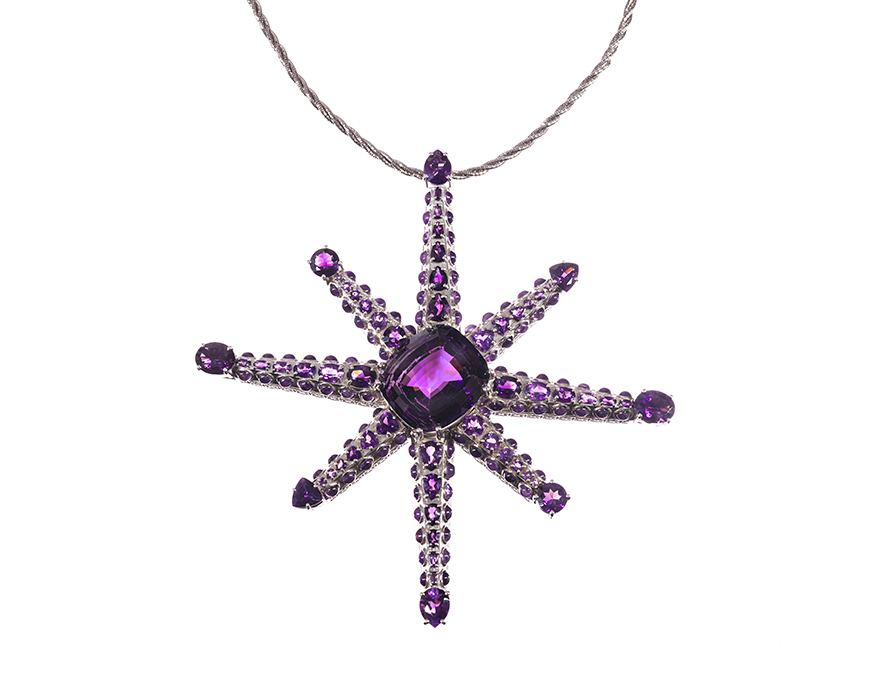
Amethyst from Arizona Four Peaks Mining Co., fourpeaksminingco.com
Amethyst
This purple quartz has been found in limited amounts—just 2,000 pounds a year—and in the rare Siberian Red color in Arizona. Source it from Arizona Four Peaks Mining Co., (480) 434-6074, fourpeaksminingco.com.
Garnets
These are common throughout the U.S. but are only available in abundance from Idaho and Arizona. Source them from Columbia Gem House, (800) 888-2444, columbiagemhouse.com.
Peridot
This lime-green gem variety of the mineral olivine is found in several locations in Arizona but is most widely available near the city of Globe on a reservation with a mine run by the Apache tribe. Source it from Barker & Co., (480) 483-0780, barkerandcompany.com.
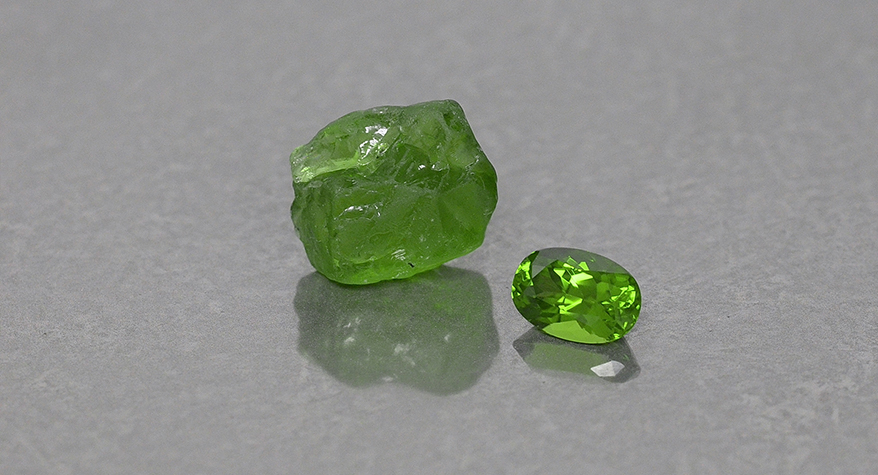
Peridot from Arizona, Barker & Co., barkerandcompany.com
Rhodochrosite
Although this pink mineral found at the now-closed Sweet Home Mine in Colorado is soft in nature, faceted samples can be set into jewelry with care. Source it from Maui Gems, (808) 573-4845, mauigems.com.
Sapphires
This sturdy variety of corundum is second only to diamond in sales in the gem world, and small samples are widely available in Montana. Source them from Potentate Mining, (905) 469-0072, potentatemining.com.
Sunstone
This copper-bearing labradorite feldspar is found in Oregon. Source it from Desert Sun Mining & Gem Co., (541) 765-2441, desertsungems.com.
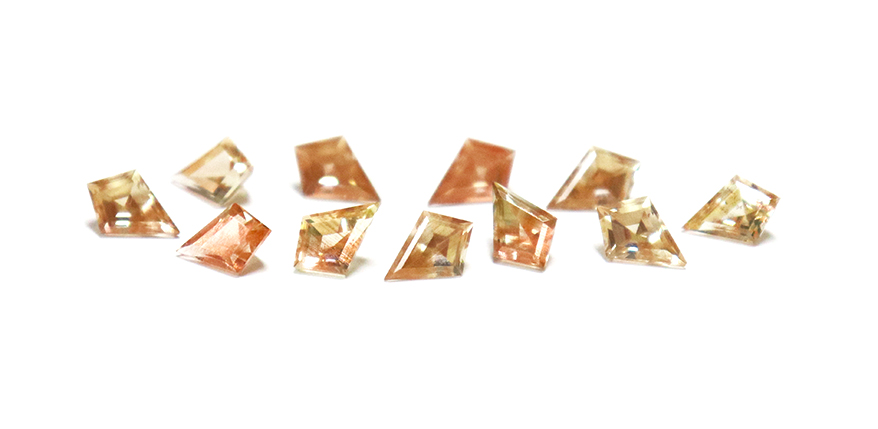
Kyte-cut sunstone from Oregon, Columbia Gem House, columbiagemhouse.com
Turquoise
Three different varieties—Bisbee, Kingman, and Sleeping Beauty—are well-known Arizona gems, though only one source (Kingman) is still actively mined. Source them from Rincon Trading, (520) 219-3058, rincontrading.com.

“Boulder opals are like Mother Nature’s little paintings—full of unexpected flashes of color and abstract patterns—and each is like a mini-masterpiece. My collection is primarily one-of-a-kind pieces, and I love that opals are, by nature, one of a kind.” — Suzy Landa, Suzy Landa Jewelry
Editor’s Note: More U.S. gems are available in smaller quantities, including agate and amethyst from Montana; amazonite from Virginia; agate from Oregon; iolite and ruby from Wyoming; moonstone from Wisconsin; opal from Oregon; and quartz from Arkansas. Source these at Columbia Gem House, (800) 888-2444, columbiagemhouse.com.

Jewelry store owners take note: This quartet of techniques represents the top ways that gems are enhanced for clarity, color, and inclusions to improve look and value. Untreated stones routinely command greater sums and often come with lab certificates stating their virgin statuses. Be sure to ask your suppliers to clearly write all treatments on purchase invoices.
Oiling & Fracture Filling (Clarity Enhancement)
1 Any stone with a surface-reaching break could be enhanced with oil or resin. Emerald is widely oiled, but even common gems like garnets can be as well. “Most understand and accept that emeralds are clarity enhanced but may not realize that many other gemstones, including tourmaline, are routinely treated this way,” explains Shane McClure, director, West Coast identification services, GIA. Disclosure matters. “If you’re paying $25,000 a carat, you probably want an unenhanced stone,” says Michael Abraham Bruder, lab manager, Gubelin Group in New York City.
Lead-Glass Filling (Composite Gems)
2 This typically happens in corundum, particularly rubies. This was a massive issue in the market more than 10 years ago and was so rampant that even the consumer press picked it up. Lead-glass-filled/composite gems are much more widely disclosed now and are recognizable under a loupe as gas bubbles. Compared to the more commercial/traditional type of heating, these stones should be priced considerably lower. “For AGL, composite rubies continue to be a big issue,” says Chris Smith, president and chief gemologist at American Gemological Laboratories (AGL).
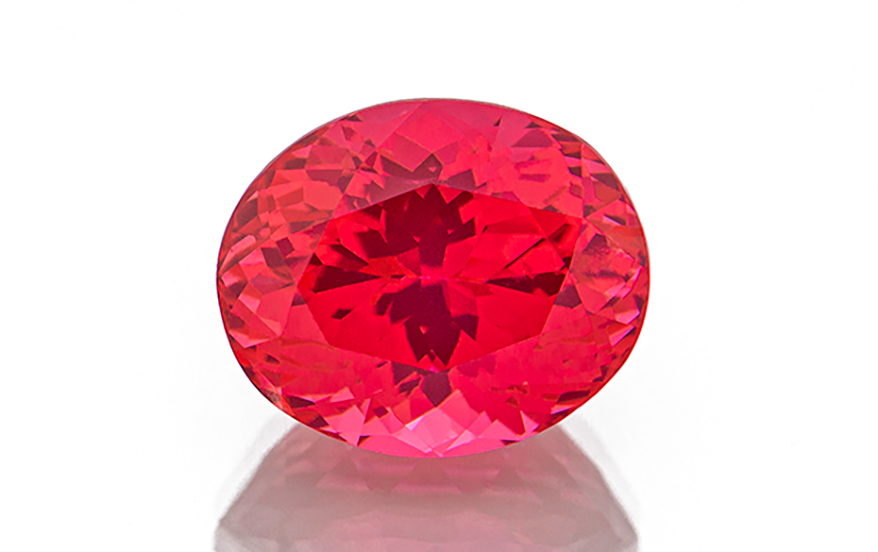
Mahenge pink spinel with heat treatment, Mayer & Watt, mayerandwatt.com
Heating
3 Many gems, including rubies, sapphires, aquamarine, and tanzanite are widely recognized as being heated to improve color and eliminate inclusions. Reputable dealers often disclose this, but sometimes gems, particularly those heated at relatively lower temperatures, are sold as natural (with no treatment). Both Stuart Robertson, research director at The GemGuide, and Smith of AGL share virtually the same observation: “It’s more common than many realize.” Another growing trend: Gems that were not traditionally treated, such as spinel, are now being heated.
Irradiation
4 Blue topaz is widely known to be irradiated to improve its color, but rarer gems are also subject to this treatment. So long as the treatment is disclosed, it’s fine, but when it’s not, buyers of irradiated stones might be paying more for a gem than it’s worth. “Irradiation can open up the color of rubies and intensify the saturation of padparadschas,” says Kim Collins of Kim Collins Gems and board president of AGTA. Another danger: The irradiated colors can fade.
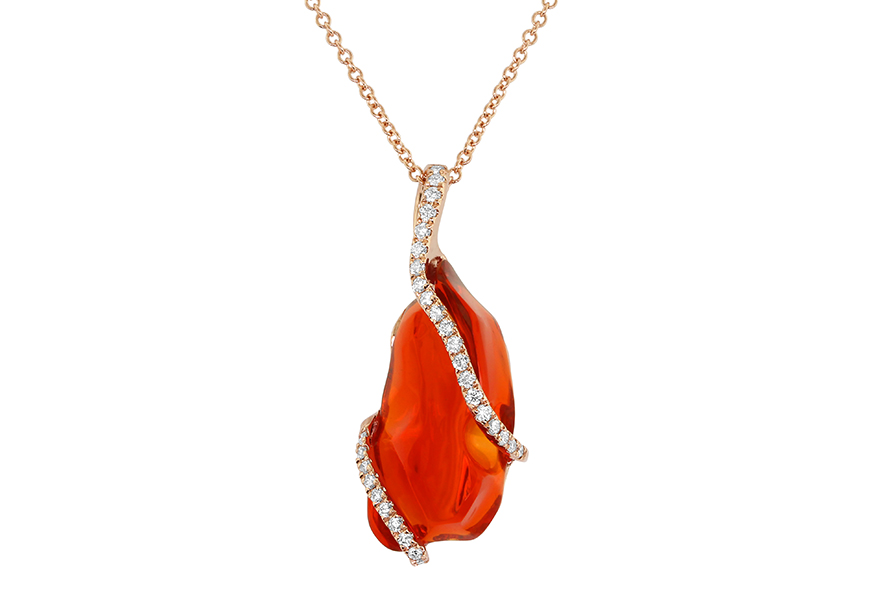
“I love fire opal! It’s like an abstract painting—it could look like a cloud or an elephant and has all those brilliant kaleidoscopic fiery colors that create a different look every time the light hits the stone.” — Yehouda Saketkhou, Yael Designs

What sells best after diamonds and sapphires? INSTORE asked the Brain Squad, and the results aren’t too surprising.
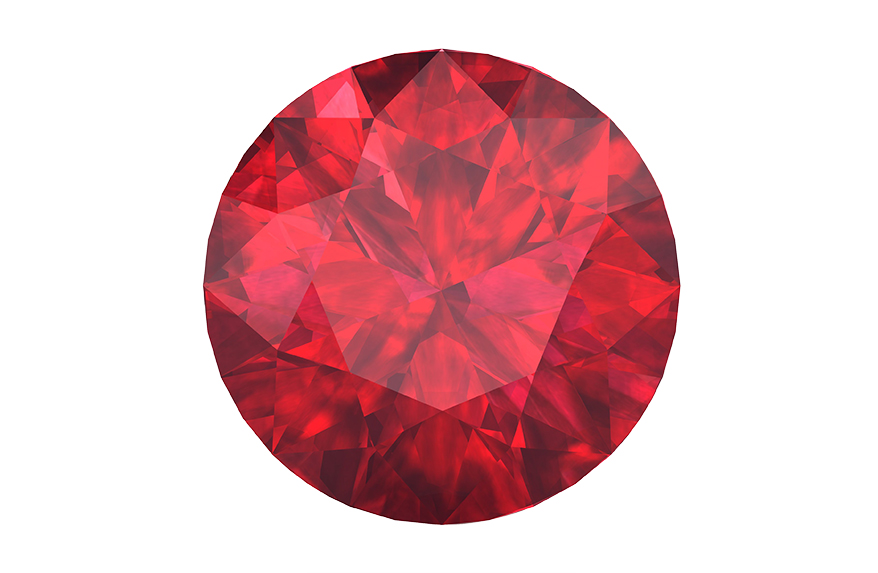
1. Ruby
2. Emerald
3. Blue topaz
4. Opal
5. Tourmaline
6. Amethyst
7. Garnet

Beyond the beauty of color, margin is another reason for retailers to love gemstones! They’re not so easy to price shop. We asked the Brain Squad which gemstone offers the best margins, and here’s how they voted.
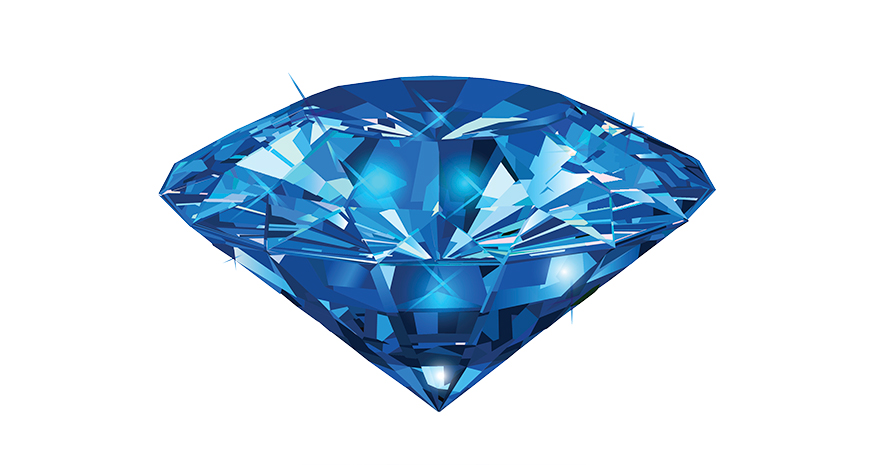
Sapphire 31%
Pearl 20%
Diamond 14%
Ruby 9%
Emerald 4%
Other* 22%
*These include tourmaline, opal, lab-grown diamonds, and others.
Advertisement